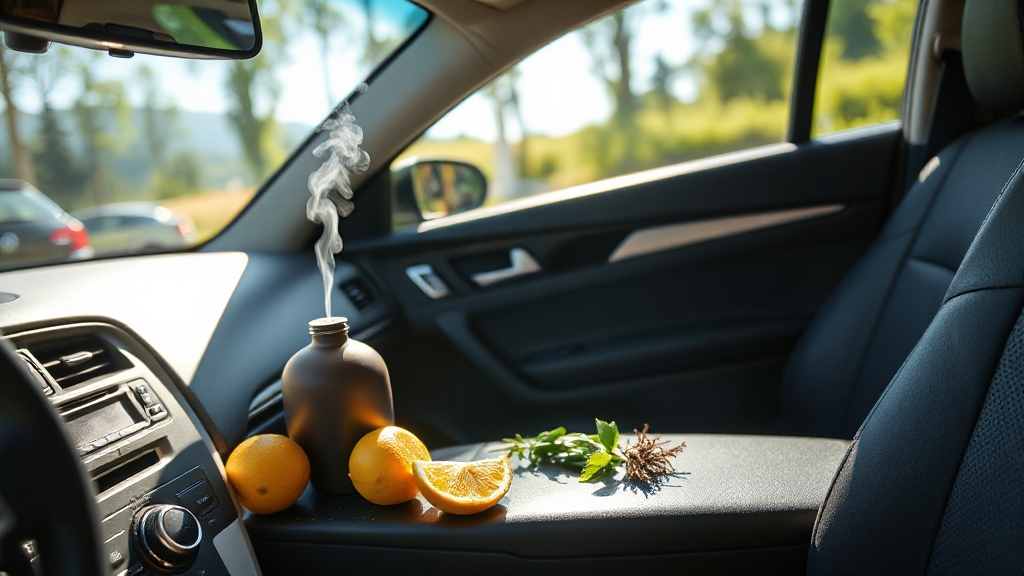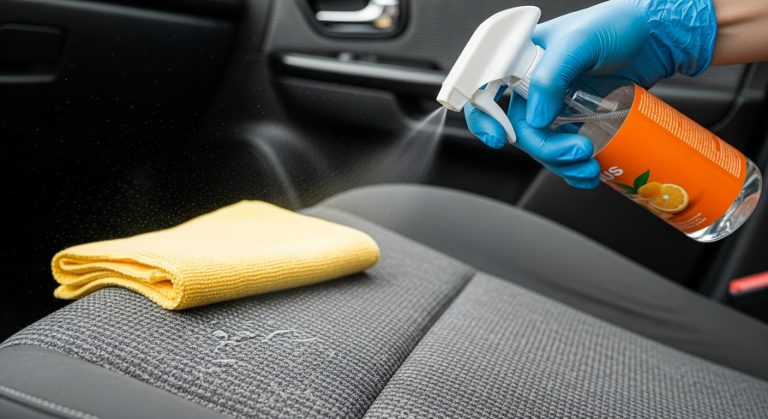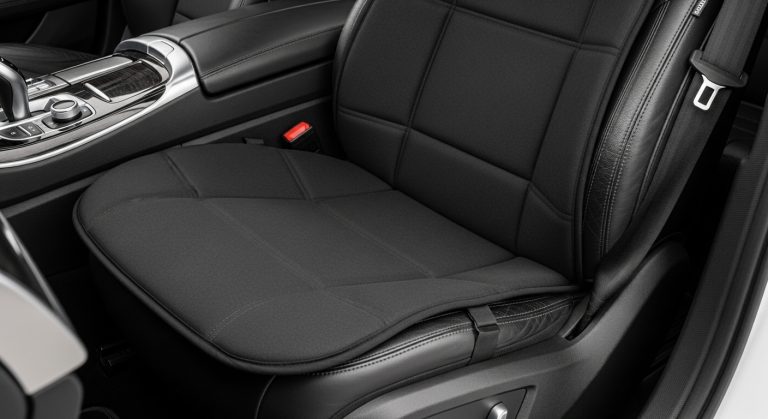To make your car smell better, start by vacuuming carpets and upholstery thoroughly, using baking soda to absorb odors before cleaning. Wipe hard surfaces and vents with mild soap and microfiber cloths, avoiding ammonia-based cleaners that can damage plastics. Replace the cabin air filter every 12,000–15,000 miles to maintain air quality. Use low-VOC deodorizing products cautiously, and keep the interior clutter-free. For all-inclusive steps on sustaining a fresh-smelling car, here’s what you need to know next.
Key Takeaways
- Vacuum and clean fabric surfaces regularly, using baking soda to absorb odors before vacuuming.
- Wipe and disinfect hard surfaces, including dashboard, door panels, and vents, with mild soap and microfiber cloths.
- Replace the cabin air filter every 12,000–15,000 miles to maintain fresh air circulation.
- Use natural or ClO₂-based deodorizing products, following instructions and ventilating the car during application.
- Remove trash, clutter, and avoid eating or smoking inside the car to prevent persistent odors.
Natural Methods to Absorb and Eliminate Odors
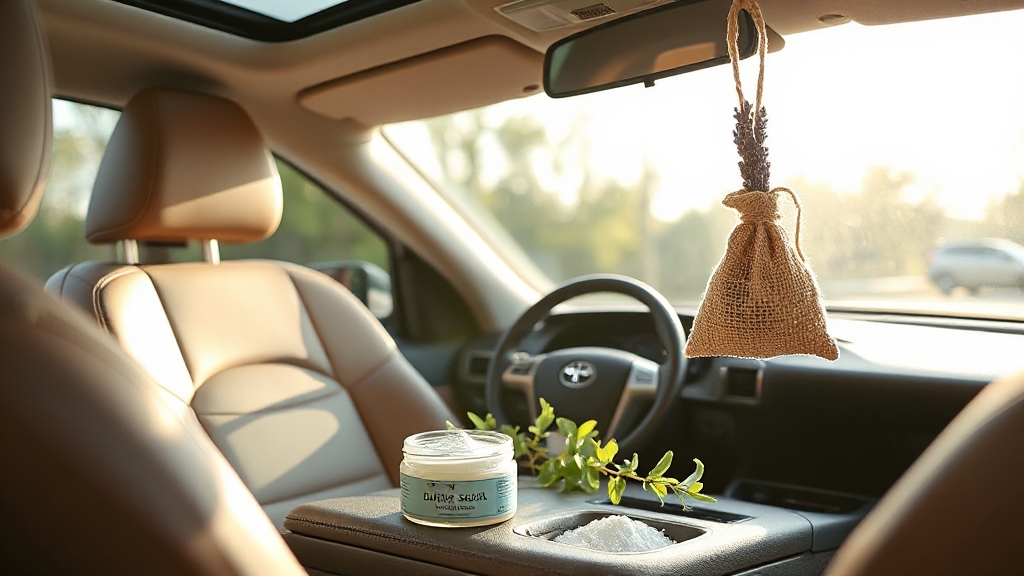
Although synthetic air fresheners can mask odors temporarily, natural methods offer more effective and lasting solutions to absorb and eliminate smells in your car. Start by vacuuming and drying all surfaces, then sprinkle baking soda liberally on carpets and seats.
Leave it overnight to neutralize odors, and vacuum thoroughly afterward to remove residues. Removing debris is essential because clearing out odor-causing items is the first step to effective odor removal.
Place bowls of white vinegar strategically inside the vehicle overnight; it neutralizes odor molecules without chemicals. Activated charcoal bags trap and eliminate smells through their porous structure—keep doors closed during treatment for maximum effect. This method is similar to how AGM batteries use absorbent glass mats to maintain durability and performance.
For a fresh aroma, position containers of citrus peels or fresh coffee grounds; they absorb odors while releasing pleasant natural scents. These approaches use widely available, chemical-free substances and ensure your car smells clean without masking odors artificially.
Effective Techniques for Cleaning Upholstery and Carpets
When preparing to clean your car’s upholstery and carpets, start by removing all clutter and large debris to make certain of thorough access to surfaces. Use a vacuum cleaner with a soft brush attachment to gently lift dirt, focusing on seams and crevices with detail tools.
It is helpful to remove mats and carpets from the vehicle for easier and more effective cleaning. Using durable materials in your car’s interior can also help reduce odor retention over time.
Pre-treat stains with spot cleaners or vinegar-water mixtures, applying only to affected areas to avoid fabric saturation. After allowing treatments to sit, agitate spots gently with a soft brush.
For deep cleaning, employ a steam cleaner following manufacturer instructions, moving slowly to loosen dirt while preventing overwetting. Incorporating innovative features like fast drying and odor-minimizing agents can enhance the freshness of your upholstery.
Finish by shampooing with a mild detergent solution, scrubbing carefully to avoid fiber damage, then absorb excess moisture with towels. Ensure complete drying in a ventilated space to prevent mold and odor development. Proper maintenance and care can extend the lifespan of your car’s interior materials and improve overall ride quality.
Maintaining Air Circulation and Cabin Air Filters
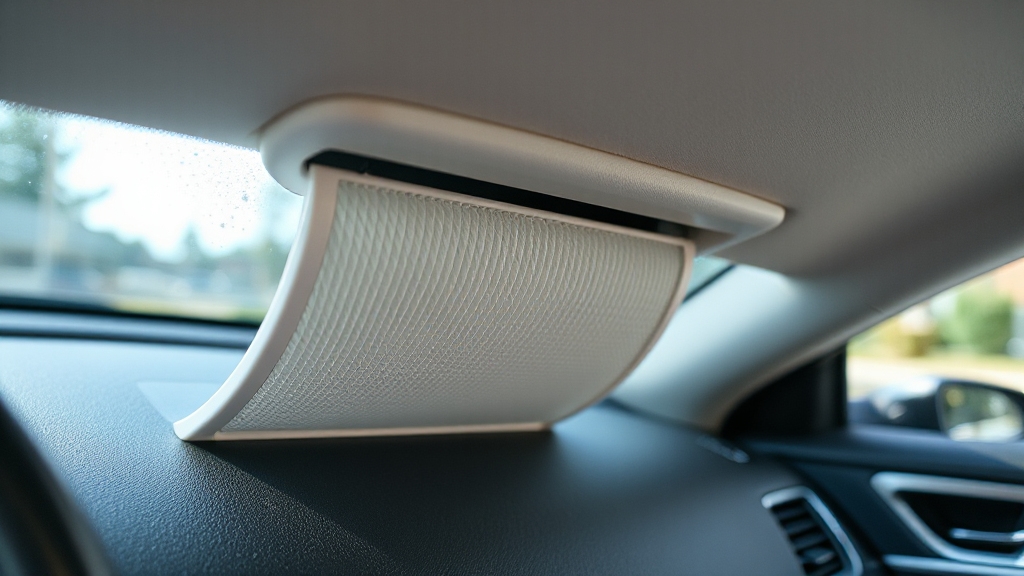
You should replace your cabin air filter every 12,000 to 15,000 miles to maintain clean airflow and reduce odors. Cabin air filters are typically located behind the glove compartment or under the dashboard, making them accessible for routine replacement filter location.
Regularly clean your air vents to prevent dust buildup that can compromise ventilation efficiency. Proper filter installation and vent maintenance ensure ideal air circulation and a fresher cabin environment. Using a high-quality filtration efficiency filter can significantly improve air quality inside your car.
Cabin Filter Replacement
How often should you replace your cabin air filter to maintain peak air quality inside your vehicle? Typically, you should replace it every 12,000 miles or once a year, whichever comes first.
If you drive in dusty or polluted areas, consider more frequent changes. To replace the filter, locate its compartment behind the glove box or under the dashboard. Remove the glove box carefully, extract the old filter noting its orientation, clean the housing, then insert the new filter following airflow direction indicators.
Wearing safety glasses and gloves during this process helps protect you from dust and debris. Regular inspection and timely replacement of the cabin filter are crucial to prevent clogging and reduced airflow.
Regular replacement prevents clogging, improves HVAC efficiency, reduces allergens, and eliminates musty odors caused by trapped debris and moisture. Maintaining a clean cabin filter ensures ideal air circulation, supports your HVAC system’s performance, and keeps your car interior smelling fresh and healthy.
Vent Cleaning Tips
Although cabin air filters play a crucial role in maintaining air quality, regular vent cleaning guarantees ideal air circulation by removing dust, mold, and bacteria trapped within the vent slats and ducts.
You should turn off the car and A/C system before cleaning, then use small, soft-bristled brushes or cotton swabs to dislodge debris. Follow by wiping vents with a damp microfiber cloth to avoid moisture buildup. Using a vacuum cleaner with hose attachment can effectively remove loose dust and dirt from vents before detailed cleaning. Regular maintenance like this is essential to prevent the build-up of contaminants that can reduce HVAC system efficiency.
Employ foam cleaners designed for automotive HVAC systems to break down residues inside vents. Compressed air helps flush out deep-seated dirt in ducts.
Monthly cleaning prevents microbial growth, odor, and respiratory risks while enhancing HVAC efficiency. Always dry vents thoroughly post-cleaning to prevent mold.
Combining vent cleaning with cabin air filter replacement optimizes cabin air purity and circulation.
Using Deodorizing Products and Treatments Safely
When selecting and applying deodorizing products for your car, understanding their chemical composition and following safety protocols is essential to minimize health risks. Many air fresheners emit VOCs, which can accumulate in confined interiors and cause respiratory irritation.
Since VOCs can negatively impact indoor air quality, it is important to use these products with care. Additionally, choosing products that maintain engine cleanliness can contribute to overall vehicle health.
Choose products listing all ingredients, favoring natural essential oils or ClO₂-based treatments for effective, residue-free odor neutralization.
Always follow manufacturer instructions precisely to avoid overexposure or chemical buildup. Proper ventilation during and after application reduces inhalation risks and VOC concentration.
- Select certified, transparent products with low or no VOCs.
- Apply gaseous treatments like ClO₂ and allow full circulation time before use.
- Avoid mixing multiple fragranced products or repeated direct sprays on upholstery.
- Ventilate thoroughly and limit exposure, especially for sensitive individuals.
Best Practices for Surface Cleaning Inside Your Vehicle
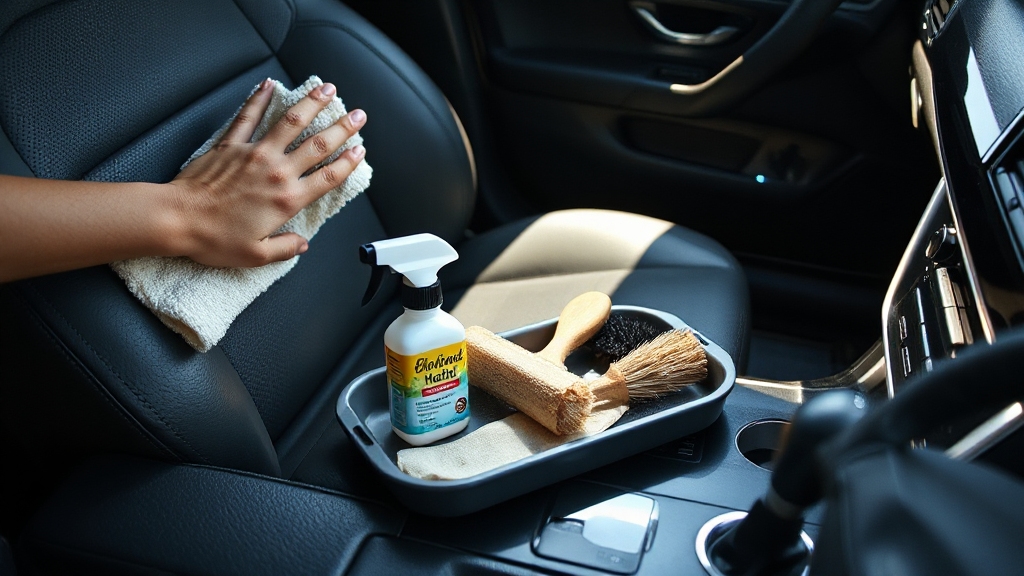
Since maintaining cleanliness directly impacts your car’s interior longevity and comfort, applying effective surface cleaning techniques is essential.
Begin by vacuuming carpets and upholstery with attachments to eliminate debris thoroughly. For fabric, use diluted mild dish soap or upholstery cleaner and agitate gently with a soft brush.
Extract moisture promptly with a wet/dry vacuum to prevent mildew. Use extractors or steam cleaners to remove dirt and moisture from carpets and mats, ensuring freshness. Regularly washing your vehicle also helps maintain overall paint condition.
Start by vacuuming carpets and upholstery, then gently clean fabric with mild soap and remove moisture quickly to avoid mildew.
Wipe hard surfaces—dashboard, door panels, and console—with a microfiber cloth dampened in mild soap or disinfecting wipes; use cotton swabs for crevices. Avoid ammonia-based cleaners to protect plastics and windows.
Condition leather using dedicated products to maintain suppleness. Clean windows with ammonia-free solutions and microfiber cloths to avoid streaks.
Finally, sprinkle baking soda on fabrics before vacuuming to absorb odors. These precise steps ensure a fresh, well-maintained interior.
Preventive Measures to Keep Your Car Smelling Fresh
To keep your car smelling fresh, you must adopt consistent preventive measures that address odor sources before they develop. Regular removal of waste and clutter is vital; don’t let trash accumulate in compartments or the trunk. Choosing tools with durability and performance can help maintain cleaning efficiency.
Vacuum fabric surfaces frequently to eliminate dirt and trapped odors. Maintain your HVAC system by cleaning vents and replacing filters to guarantee clean air circulation. Cleaning your air vents helps keep air quality fresh by removing dust and debris that can distribute unpleasant odors.
Avoid introducing new odors by refraining from eating, smoking, or transporting pets without proper cleaning afterward.
- Remove all trash daily and clear clutter to prevent moisture and odor buildup.
- Vacuum upholstery and mats regularly, using fabric fresheners or baking soda.
- Clean and service air vents, replace cabin filters, and run the AC system often.
- Avoid food, smoking, and spills inside the car to minimize odor sources.
Frequently Asked Questions
Can Certain Car Air Fresheners Damage Upholstery or Electronics?
Yes, certain car air fresheners can damage upholstery or electronics. If you spray directly on fabrics or plastics, solvents and fragrances may cause discoloration, staining, or surface degradation.
Applying sprays near electronic components risks aerosol residue entering sensitive parts, potentially causing corrosion or malfunction over time.
To protect your car, avoid direct application on surfaces, choose fresheners made for automotive interiors, and test new products on small areas before full use.
How Do Weather Conditions Affect Car Odor Retention?
Think of your car’s interior like a sponge soaking up scents—weather conditions squeeze or release those odors.
Hot temperatures speed up chemical emissions, making smells stronger but shorter-lived, while cold slows them down, causing odors to linger.
High humidity traps moisture, encouraging mold growth and musty smells, whereas dry air limits that.
Ventilation plays a key role too; closed windows trap odors, but fresh airflow helps disperse them efficiently.
Are Essential Oil Diffusers Safe to Use Inside Cars?
You can safely use essential oil diffusers in cars if you choose units designed for automotive use and follow guidelines. Use diffusers moderately to avoid overpowering scents or window fogging, ensuring good ventilation by using your car’s air system.
Avoid oils toxic to pets, like tea tree or eucalyptus, and monitor for allergic reactions. Proper use enhances air quality and comfort without compromising safety or vehicle interior integrity.
Can Pets Cause Long-Term Odor Issues Beyond Cleaning?
Yes, pets can cause long-term odor issues beyond simple cleaning. Microorganisms like bacteria and yeast in pet fur and urine residues embed deeply into car upholstery, carpets, and air filters. These microbes continuously produce odor molecules, making odors persist despite surface cleaning.
To effectively address this, you must remove all pet hair, use enzymatic cleaners, replace or clean air filters regularly, and dry surfaces thoroughly to prevent microbial regrowth and lasting smells.
Does Parking Location Influence How a Car Smells?
Yes, your parking location markedly influences your car’s odor. Enclosed or poorly ventilated spots trap exhaust fumes and volatile organic compounds, causing odors to intensify inside.
Parking near smoking areas or places with biological waste exposes your car to persistent smells. High humidity and heat in certain environments promote mold and chemical off-gassing, altering scent profiles.
Choosing well-ventilated, clean parking spots helps maintain better in-cabin air quality and reduces odor buildup.
Don’t Just Mask It—Own a Car That Smells Amazing Every Day
If you want your car to smell like a fresh breeze instead of a forgotten gym sock, you’ll need more than just air fresheners masking the problem. Regularly clean upholstery, replace cabin filters, and use natural odor absorbers—because relying solely on scented sprays is like putting a band-aid on a leaky fuel tank. Keep up with preventive maintenance; otherwise, your car’s aroma might just become its most memorable feature. Trust me, your nose will thank you.

